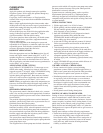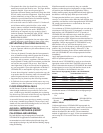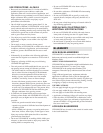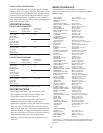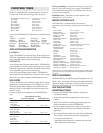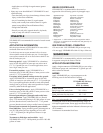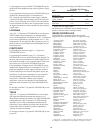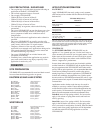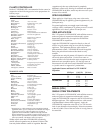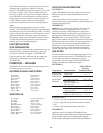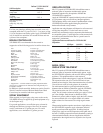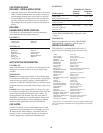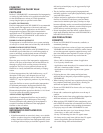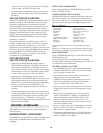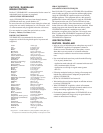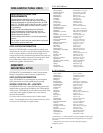
PLANTS CONTROLLED
DuPont™ VELPAR® DF is recommended for the control or
suppression of the following species in site preparations for
forestry crops:
HERBACEOUS PLANTS
WOODY PLANTS
*
Suppression is a visible reduction in plant competition (reduced
population and/or vigor) as compared to an untreated area. Degree
of suppression will vary with rate applied, size of plants at
application and environmental conditions following treatment.
Species indicated above, especially resprouts of these species, may
require a follow up treatment for acceptable control. Burning, as a
follow up treatment, will enhance control of resprouts.
Within several weeks after VELPAR® DF activation by
rainfall, affected vegetation may be burned, if desired. This
burn may further enhance control of vegetation. Burn the
vegetation only after any residual stand is completely
defoliated, at least twice, allowing for sufficient root uptake of
VELPAR® DF. In the West, results may take one to two years
in areas of low rainfall.
SPRAY EQUIPMENT
When applied as a liquid spray using water as the carrier,
VELPAR® DF may be applied by ground equipment or by air
(helicopter only).
For ground application, use enough water for thorough
coverage, usually a minimum of 25 gallons per acre. For aerial
applications, use at least 5 gallons of water per acre.
GRID APPLICATION
Mix 2 2/3 pounds of VELPAR® DF with sufficient water to
make one gallon of suspension and thoroughly agitate.
Intermittent agitation may be required to maintain the
VELPAR® DF in suspension.
Apply the VELPAR® DF suspension directly to the soil
surface in a grid pattern using an exact delivery handgun
applicator. This equipment delivers a thin stream of
predetermined volume. VELPAR® DF should be applied
during the period from hardwood bud break to early
summer.
Application rate and grid pattern will depend on soil texture
and woody plant composition. Use the lower rates on
coarse textured soils and when the major component of the
hardwoods are susceptible species. Use the high rates on
fine-textured soils and where weeds identified in this label
as “partial control or suppression” predominate.
Application Patterns and Rates For VELPAR® DF
Suspension
ML/Spot Grid (Ft) Lb/Acre
Coarse 0.6 3 X 3 2
2.0 4 X 4 4
3.1 4 X 6 4
Medium/Fine 1.6 3 X 3 5.3
2.8 4 X 4 5.3
3.5 4 X 4 6.6
5.2 4 X 6 6.6
BASAL (SOIL)
SINGLE STEM TREATMENTS
Mix 2 2/3 pounds of VELPAR® DF with sufficient water to
make one gallon of suspension and thoroughly agitate.
Apply the VELPAR® DF suspension with an exact-delivery
handgun applicator. This equipment delivers a thin stream
of predetermined volume when triggered. Apply the
VELPAR® DF suspension at the rate of 2 to 4 ml for each
inch of stem diameter at breast height. Direct the treatment
to the soil within 3 feet of the root collar of woody plants to
be controlled.
Ash Fraxinus spp
Aspen, big tooth Populus grandidentata
Aspen, trembling Populus tremuloides
Birch Betula spp
Blackgum Nyssa sylvatica
Cherry, black Prunus serotina
Deerbrush Ceanothus integerrimus
Dogwood, flowering* Cornus florida
Elm Ulmus spp
Hawthorn Crataegus spp
Hazel Corylus spp
Hickory Carya spp
Honeysuckle* Lonicera spp
Manzanita, Greenleaf Arctostaphylos patula
Maple, red* Acer rubrum
Oaks Quercus spp
Poplar, balsam Populus balsamifera
Snowbrush (varnishleaf) Ceanothus velutinus
Sourwood* Oxydendrum arboretum
Sweetgum Liquidambar spp
Willows Salix spp
Asters
Aster, heath* Aster ericoides
Barnyardgrass Echinochloa crus-galli
Bentgrass Agrostis spp
Bluegrass, annual Poa annua
Bromegrass Bromus spp
Carrot, wild Daucus carota
Crabgrass* Digitaria spp
Daisy, oxeye Chrysanthemum leucanthemum
Dandelion, common* Taraxacum officinale
Dandelion, false*
(spotted catsear) Hypochaeris radicata
Dock, curly* Rumex crispus
Elksedge Carex geyeri
Fescue* Festuca spp
Fireweed*(willowweed) Epilobium angustifolium
Fleabane Conyza spp
Foxtail Setaria spp
Goldenrod* Solidago spp
Groundsel, common Senecio vulgaris
Horseweed/marestail Conyza canadensis
Orchardgrass * Dactylis glomerata
Pinegrass Calamagrostis rubescens
Quackgrass* Agropyron repens
Ragweed, common Ambrosia elatior
Ryegrass, Italian (annual) Lolium multiflorum
Ryegrass, perennial* Lolium perenne
Smartweed,
Pennsylvania Polygonum pensylvanicum
Squawcarpet Ceanothus prostratus
Thistle, Canada* Cirsium arvense
Velvetgrass, common Holcus lanatus
13



